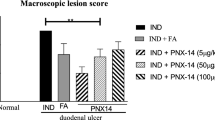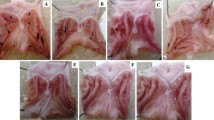Abstract
The purposes of this study were to determine whether inhibition of cyclooxygenase is a mechanism by which cysteamine and mepirizole produce duodenal ulcers, identify qualitative or quantitative differences in prostanoid production between gastric mucosa and duodenum, and determine whether differences in cyclooxygenase sensitivity to inhibition by aspirin exist between these two tissues. In fed female rats, gastric mucosal prostaglandin E2 (PGE2) and prostacyclin (PGI2) generation was 235±25 and 832±40 ng/g/min, respectively, whereas full-thickness duodenal PGE2 and PGI2 generation was 665±46 and 662±49 ng/g/min, respectively. Over an intraperitoneal dose range of 0– 25 mg/kg, aspirin-induced cyclooxygenase inhibition was dose-dependent and similar for the two tissues. Duodenal ulceration (16.7 mm2) produced by cysteamine, 425 mg/kg, was associated with a 46% reduction in duodenal PGE2 generation, while having no effect on PGI2 generation; however, cysteamine, 213 mg/kg, produced no visible duodenal mucosa injury yet reduced duodenal PGE2 generation 39% compared to control values. In fed male rats, gastric mucosal PGE2 and PGI2 generation was 179± 18 and 813± 61 ng/g/min, respectivley, whereas duodenal PGE2 and PGI2 generation was 321± 27 and 454± 38 ng/g/min, respectively. Duodenal ulceration (7.7 ± 2.3 mm2) produced by oral mepirizole was associated with a 63% reduction in duodenal PGE2 generation compared to control values, while having no effect on PGI2 generation. Subcutaneous aspirin, 100 mg/kg, which reduced duodenal PGE2 generation to a greater degree than either ulcerogen, given in conjunction with pentagastrin, did not produce visible duodenal ulceration. It therefore seems unlikely that reduced PGE2 generation within the duodenum is the primary mechanism of gross injury associated with these two ulcerogens.
Similar content being viewed by others
References
Seyle H, Szabo S: Experimental model for production of perforating duodenal ulcers by cysteamine in the rat. Nature 244:458–459, 1973
Kirkegaard P, Paulsen SS, Lond FB, Halse C, Christiansen J: Cysteamine-induced duodenal ulcer and acid secretion in the rat. Scand J Gastroenterol 15:621–624, 1980
Gallagher GT, Szabo S: Secretory changes associated with chemically-induced duodenal ulceration: Simultaneous measurement of acid, pepsin, base, and pancreatic enzymes in rats with chronic gastric fistula. Digestion 29:73–84, 1984
Kirkegaard P, Peleisen B, Skov Olsen P, Poulsen SS, Christiansen J: The mechanism of gastric release in cysteamine-induced duodenal ulcer. Scand J Gastroenterol 17:609–612, 1982
Adler RS, Gallagher GT, Szabo S: Duodenal ulcerogens cysteamine and propionitrile decrease duodenal neutralization of acid in the rat. Dig Dis Sci 28:716–723, 1983
Briden S, Flemstrom G, Kivilaskso E: Cysteamine and propionitrile inhibit the rises of duodenal mucosal alkaline secretion in response to luminal acid in rats. Gastroenterology 88:295–302, 1985
Kirkegaard P, Paulsen SS, Halser C, Loud EB, Skov Olsen P, Christiansen J: The effect of cysteamine on Brunner gland secretion in the rat. Scand J Gastroenterol 16:93–96, 1981
Tanaka H, Shuto K, Marumo H: Effect ofN-acetyl-l-glutamine aluminum complex (KW-110) on experimental duodenal ulcers in rats. Pharmacometrics 20:185–193, 1980
Okabe S, Ishihara Y, Inoo H, Tanaka H: Mepirizole-induced duodenal ulcers in rats and their pathogenesis. Dig Dis Sci 27:242–249, 1982
Tabata K, Jacobson ED, Chen M, Murphy R, Joffe SW: Decrease in alkaline secretion during duodenal ulceration induced by mepirizole in rats. Gastroenterology 87:396–401, 1984
Flemstrom G, Garner A: Gastroduodenal HCO3 transport: Characteristics and proposed role in acidity regulation and mucosal protection. Am J Physiol 242:G183-G193, 1982
Piper P, Vane JR: The release of prostaglandins from lung and other tissues. Ann NY Acad Sci 180:363–385, 1969
Whittle BJR, Higgs GA, Eakins KE, Moncada S, Vane JR: Selective inhibition of prostaglandin production in inflammatory exudates and gastric mucosa. Nature 284:271–273, 1980
Bauminger S, Zor J, Lindner AR: Radioimmunological assay of prostaglandin synthetase activity. Prostaglandins 4:313–324, 1973
Ligumsky M, Grossman MI, Kauffman GL Jr: Endogenous gastric mucosal prostaglandin: Their role in mucosal integrity. Am J Physiol 242:G337-G341, 1982
Taheuchi K, Furukawa O, Tanoka H, Okabe S: A new model of duodenal ulcers induced in rats by indomethacin plus histamine. Gastroenterology 90:636–645, 1986
Flemstrom G, Garner A, Wylander O, Hurst BC, Heylings JR: Surface epithelial HCO3 transport by mammalian duodenumin vivo. Am J Physiol 243:G348-G358, 1982
Leung FW, Guth PH: An ulcerogenic dose of cysteamine significantly reduces duodenal acid neutralizing capacity and mucosal blood flow. Gastroenterology 88:1472, 1985 (abstract)
Ahlquist DA, Dozois RR, Zinmeister AR, Malagelada J: Duodenal prostaglandin synthesis and acid load in health and in duodenal ulcer disease. Gastroenterology 85:522–528, 1983
Lockard OO, Ivey KJ, Butt JH, Silvoso GR, Sisk C, Holt S: The incidence of duodenal lesions in patients with rheumatic diseases on chronic aspirin therapy. Gastrointest Endos 26:5–7, 1980
Author information
Authors and Affiliations
Additional information
Supported by grant AM 17328 from NIADDK.
Rights and permissions
About this article
Cite this article
Kauffman, G.L., Kolve, E., Walfisch, S. et al. Role of prostanoids in experimental duodenal ulcer in rat. Digest Dis Sci 33, 667–672 (1988). https://doi.org/10.1007/BF01540428
Received:
Revised:
Accepted:
Issue Date:
DOI: https://doi.org/10.1007/BF01540428




